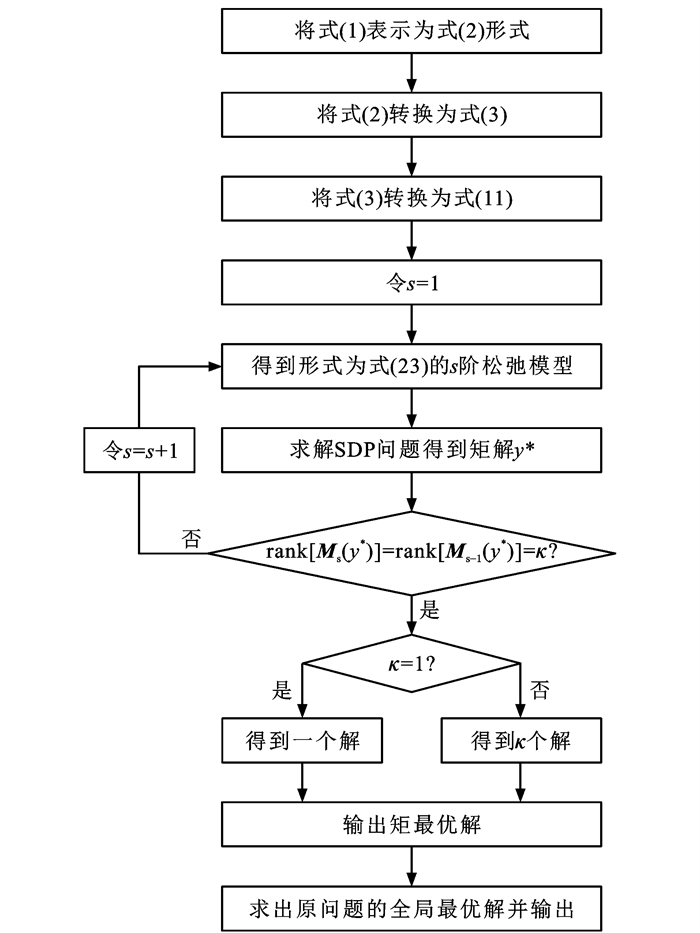| [1] |
FARAHANI R Z, MIANDOABCHI E, SZETO W Y, et al. A review of urban transportation network design problems[J]. European Journal of Operational Research, 2013, 229(2): 281-302. doi: 10.1016/j.ejor.2013.01.001
|
| [2] |
BOYCE D E. Urban transportation network-equilibrium and design models: recent achievements and future prospects[J]. Environment and Planning A: Economy and Space, 1984, 16(11): 1445-1474. doi: 10.1068/a161445
|
| [3] |
MAGNANTI T L, WONG R T. Network design and transportation planning: models and algorithms[J]. Transportation Science, 1984, 18(1): 1-55. doi: 10.1287/trsc.18.1.1
|
| [4] |
FRIESZ T L. Transportation network equilibrium, design and aggregation: key developments and research opportunities[J]. Transportation Research Part A: General, 1985, 19(5/6): 413-427.
|
| [5] |
MIGDALAS A. Bilevel programming in traffic planning: models, methods and challenge[J]. Journal of Global Optimization, 1995, 7(4): 381-405. doi: 10.1007/BF01099649
|
| [6] |
YANG Hai, BELL M G H. Models and algorithms for road network design: a review and some new developments[J]. Transport Reviews, 1998, 18(3): 257-278. doi: 10.1080/01441649808717016
|
| [7] |
XU Xiang-dong, CHEN A, YANG Chao. A review of sustainable network design for road networks[J]. KSCE Journal of Civil Engineering, 2016, 20(3): 1084-1098. doi: 10.1007/s12205-016-1729-1
|
| [8] |
MENG Qiang, YANG Hai. Benefit distribution and equity in road network design[J]. Transportation Research Part B: Methodological, 2002, 36(1): 19-35. doi: 10.1016/S0191-2615(00)00036-9
|
| [9] |
GAO Zi-you, SUN Hui-jun, ZHANG Hao-zhi. A globally convergent algorithm for transportation continuous network design problem[J]. Optimization and Engineering, 2007, 8(3): 241-257. doi: 10.1007/s11081-007-9015-1
|
| [10] |
WANG D Z W, LO H K. Global optimum of the linearized network design problem with equilibrium flows[J]. Transportation Research Part B: Methodological, 2010, 44(4): 482-492. doi: 10.1016/j.trb.2009.10.003
|
| [11] |
YANG Hai, BELL M G H. A capacity paradox in network design and how to avoid it[J]. Transportation Research Part A: Policy and Practice, 1998, 32(7): 539-545. doi: 10.1016/S0965-8564(98)00017-2
|
| [12] |
CHIOU S W. A hybrid approach for optimal design of signalized road network[J]. Applied Mathematical Modelling, 2008, 32(2): 195-207. doi: 10.1016/j.apm.2006.11.007
|
| [13] |
YANG Hai. Sensitivity analysis for the elastic-demand network equilibrium problem with applications[J]. Transportation Research Part B: Methodological, 1997, 31(1): 55-70. doi: 10.1016/S0191-2615(96)00015-X
|
| [14] |
YANG Hai, SASAKI T, ⅡDA Y, et al. Estimation of origin -destination matrices from link traffic counts on congested networks[J]. Transportation Research Part B: Methodological, 1992, 26(6): 417-434. doi: 10.1016/0191-2615(92)90008-K
|
| [15] |
YANG Hai. Heuristic algorithms for the bilevel origin-destination matrix estimation problem[J]. Transportation Research Part B: Methodological, 1995, 29(4): 231-242. doi: 10.1016/0191-2615(95)00003-V
|
| [16] |
BEN-AYED O, BLAIR C E. Computational difficulties of bilevel linear programming[J]. Operations Research, 1990, 38(3): 556-560. doi: 10.1287/opre.38.3.556
|
| [17] |
NIE Jia-wang, WANG Li, YE J J, et al. A Lagrange multiplier expression method for bilevel polynomial optimization[J]. SIAM Journal on Optimization, 2021, 31(3): 2368-2395. doi: 10.1137/20M1352375
|
| [18] |
BEN-AYED O, BLAIR C E. Computational difficulties of bilevel linear programming[J]. Operations Research, 1990, 38(3): 556-560. doi: 10.1287/opre.38.3.556
|
| [19] |
LAMPARIELLO L, SAGRATELLA S. A bridge between bilevel programs and Nash games[J]. Journal of Optimization Theory and Applications, 2017, 174(2): 613-635. doi: 10.1007/s10957-017-1109-0
|
| [20] |
高自友, 张好智, 孙会君. 城市交通网络设计问题中双层规划模型、方法及应用[J]. 交通运输系统工程与信息, 2004, 4(1): 35-44. doi: 10.3969/j.issn.1009-6744.2004.01.009GAO Zi-you, ZHANG Hao-zhi, SUN Hui-jun. Bi-level programming models, approaches and applications in urban transportation network design problems[J]. Communication and Transportation Systems Engineering and Information, 2004, 4(1): 35-44. (in Chinese) doi: 10.3969/j.issn.1009-6744.2004.01.009
|
| [21] |
ABDULAAL M, LEBLANC L J. Continuous equilibrium network design models[J]. Transportation Research Part B: Methodological, 1979, 13(1): 19-32. doi: 10.1016/0191-2615(79)90004-3
|
| [22] |
MARCOTTE P. Network optimization with continuous control parameters[J]. Transportation Science, 1983, 17(2): 181-197. doi: 10.1287/trsc.17.2.181
|
| [23] |
DAVIS G A. Exact local solution of the continuous network design problem via stochastic user equilibrium assignment[J]. Transportation Research Part B: Methodological, 1994, 28(1): 61-75. doi: 10.1016/0191-2615(94)90031-0
|
| [24] |
MIRRLEES J A. The theory of moral hazard and unobservable behaviour: Part Ⅰ[J]. The Review of Economic Studies, 1999, 66(1): 3-21. doi: 10.1111/1467-937X.00075
|
| [25] |
DEMPE S, DUTTA J. Is bilevel programming a special case of a mathematical program with complementarity constraints?[J]. Mathematical Programming, 2012, 131(1/2): 37-48.
|
| [26] |
YE J J, ZHU Dao-li. Optimality conditions for bilevel programming problems[J]. Optimization, 1995, 33(1): 9-27. doi: 10.1080/02331939508844060
|
| [27] |
YE J J, ZHU Dao-li. New necessary optimality conditions for bilevel programs by combining the MPEC and value function approaches[J]. SIAM Journal on Optimization, 2010, 20(4): 1885-1905. doi: 10.1137/080725088
|
| [28] |
MENG Q, YANG H, BELL M G H. An equivalent continuously differentiable model and a locally convergent algorithm for the continuous network design problem[J]. Transportation Research Part B: Methodological, 2001, 35(1): 83-105. doi: 10.1016/S0191-2615(00)00016-3
|
| [29] |
LI Chang-min, YANG Hai, ZHU Dao-li, et al. A global optimization method for continuous network design problems[J]. Transportation Research Part B: Methodological, 2012, 46(9): 1144-1158. doi: 10.1016/j.trb.2012.05.003
|
| [30] |
JEYAKUMAR V, LASSERRE J B, LI G, et al. Convergent semidefinite programming relaxations for global bilevel polynomial optimization problems[J]. SIAM Journal on Optimization, 2016, 26(1): 753-780. doi: 10.1137/15M1017922
|
| [31] |
PARRILO P A. Semidefinite programming relaxations for semialgebraic problems[J]. Mathematical Programming, 2003, 96(2): 293-320. doi: 10.1007/s10107-003-0387-5
|
| [32] |
LASSERRE J B. Global optimization with polynomials and the problem of moments[J]. SIAM Journal on Optimization, 2001, 11(3): 796-817. doi: 10.1137/S1052623400366802
|
| [33] |
CURTO R E, FIALKOW L A. Recursiveness, positivity, and truncated moment problems[J]. Houston Journal of Mathematics, 1991, 17(4): 603-635.
|
| [34] |
STURM J F. Using SeDuMi 1.02, a MATLAB toolbox for optimization over symmetric cones[J]. Optimization Methods and Software, 1999, 11(1/2/3/4): 625-653.
|
| [35] |
TÜTÜNCÜ R H, TOH K C, TODD M J. Solving semidefinite -quadratic-linear programs using SDPT3[J]. Mathematical Programming, 2003, 95(2): 189-217. doi: 10.1007/s10107-002-0347-5
|
| [36] |
HENRION D, LASSERRE J B. Detecting global optimality and extracting solutions in GloptiPoly[M]//HENRION D, GARULLI A. Positive Polynomials in Control: Lecture Notes in Control and Information Science. Berlin: Springer, 2005: 293-310.
|
| [37] |
张小宁. 双层优化交通模型及其算法[J]. 同济大学学报(自然科学版), 2005, 33(2): 169-173. doi: 10.3321/j.issn:0253-374X.2005.02.007ZHANG Xiao-ning. Bi-level optimization in transportation analysis[J]. Journal of Tongji University (Natural Science), 2005, 33(2): 169-173. (in Chinese) doi: 10.3321/j.issn:0253-374X.2005.02.007
|





 下载:
下载:



